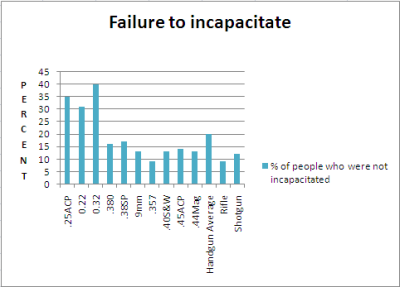Frank - thanks for the response
We're arguing across different points, and I think you've got your basic premise flawed.
You *don't* need to completely incapacitate/kill your assailant in order to successfully defend yourself. Killing or otherwise completely disabling your assailant is the 'most sure' way - but .22 is perfectly adequate for 1st shot stops.
The larger calibers are *much* better eventual incapacitation (that is, the people who weren't stopped on 1st shot, but did not escape) - but there are virtually no circumstances where you are justified in self defense where a bleed out is going to be a viable tactic. If the guy was close enough / dangerous enough to justify shooting, he is close enough to close and stab you / shoot back *before* he bleeds out.
So in the hypothetical case of someone who is willing to rage past a gun shot wound to continue attacking you, if you didn't put them down instantly on the first hit, they *are* going to be able to close before that hit eventually takes them out of the fight. (Or they weren't very close in the first place). Once I've put a shot in someone, and he runs away, I am perfectly satisfied with that result. I've no need to chase him down and kill him.
Again, I'm not disputing the ability of a large, powerful cartridge to eventually subdue an attacker. But killing the other guy isn't the point. The point is defending yourself. If you shoot him, an he runs away, that's a win from the self defense standpoint. A gun that was 100% effective without having to fire a shot would be the *ultimate* self defense weapon.
The gun that kills or incapacitates in a single shot is ideal, and in that category, only the shotgun & centerfire rifles really stand out as significantly 'better' than a .22 mag.
Which brings me back full circle.
A .22 isn't a great gun for guaranteeing you can bleed out an attacker with one shot, but it's one of the best when it comes to actually protecting yourself.
But to answer some of your specific points:
Originally Posted by The_Doctor
...But .22 (all flavors) has a lower number of shots fired to stop attackers, higher fatality rate, and generally 'just as good' as any of the higher caliber pistols....
What's your evidence. Certainly not Ellifritz' study when you include the data on failures to incapacity, and certainly not on the basis of wound physiology.
Failure to eventually incapacitate is a tertiary measure. I may have a failure of imagination, but unless I was being threatened by a deadly weapon, OR my assailant was approaching physical distance, I would't feel justified in shooting him. If I *WAS* being threatened by a deadly weapon, or at extremely close range, the only shot that matters is the first. After that it's a crapshoot.
The article you posted goes on to make it clear that the primary benefits of a larger cartridge are in the ability to engage at longer ranges, and the need to shoot through secondary cover (car doors, etc). Those needs are why the military and LEO carry larger caliber pistols. They often need to use their weapons offensively, at longer distances, and against people who have use of cover.
None of that applies in a defensive situation.
I'm not arguing that *you* shouldn't carry whatever you feel is best for yourself, but I also think that telling people not to carry a .22 for secondary or tertiary reasons is doing them a disservice.
If you read another one of Ellifritz's articles he makes this statement:
(From Ellifritz)
Here's the good news for the .22 carriers...
In Claude's lifetime study of defensive gun uses, he has yet to find a single case where an armed citizen was killed by a criminal after the criminal had taken at least one .22 round. In the case of civilian defensive gun usage, the criminal almost always flees after the first hit. I have been unable to find any gunfights that prove Claude wrong.
http://www.buckeyefirearms.org/using-22-self-defense
To me, that is the proof in the pudding - in the Ellifritz's (and other expert's) review of the actual data, .22 pistols have had a 100% success rate (if you can hit the attacker) in keeping the defending civilian alive.

